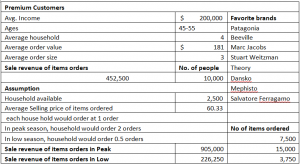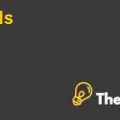MBA Case Study
Additionally, in an attempt to better manage its operations, the company had divided its customers into different segments, which consisted of premium customers, who were the most profitable and loyal towards the site and were considered as recurring customerswho were highly costly to acquire with the potential to purchase higher value items for the store. Secondly, young professionals, who had trouble managing their work life were not that costly to acquire in the market and they were considered the least loyal customers for the company. Thirdly, the off-price customers were frequent users of the internet and they compared the price of the product offered by them and others available in the market, which allowedthese users to establish their purchasing patterns using the comparative analysis. It was assessedthat these users’ buying patterns were motivated by any discount offers given by various sites available online. Lastly, the family customers, who were busy with their families spent the least amount of time on the site and were considered least profitable for the company, attributed to their higher return rates.
However, it was determined that the management of the company faced a major challenge in developing effective and efficient pricing policies, which allowed the managementto target the customers present in different consumer segments developed by the senior management of the company. This, as a result, allowed the management to assess and evaluate the driving forces behind its customers segments, which helped them to determine the factor responsible for these driving forces, which affected the customers buying patterns in those segments. Due to this, the company was able to increase its share in the online market and was able to enhance its economies of scale and profitability in the market.
Pricing Policies
The pricing policies of Zappos.com can be determined from the data provided in the case and by making certain assumptions, we would be able toevaluate sales revenues generated with respect to the customers in their segments.Moreover, pricing for each item with respect to the segments isillustrated below.
Premium Customers
The premium customers segments developed by the management of the company comprise of those customers in the market, who are loyal and recurring and account towards providing the most profit to the online store. The pricing policy is represented in the exhibit below.
MBA Case Study Harvard Case Solution & Analysis
In order to calculate the selling price of each item ordered, the total premium household available to the online store was assumed at 2,500 and the average number of people in the household was 4 people. Furthermore, it can be determined that the average value of the order amounts to $181 and the average items order in each order amounts to 3 item. Therefore, the average selling price of each order can be determined amounting at $60.33., which would enable us to evaluate the total revenues generated by order, amounting at $452,500 based on the assumption that each household would order at least one order under normal seasonal condition. Moreover, the total revenues generated under peak seasons amount to $905,000, where it was assumed that each household would order at least two order, whereas, the revenues generated under off-seasons amounted to $226,250.........................
This is just a sample partial case solution. Please place the order on the website to order your own originally done case solution.










